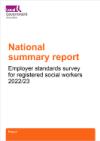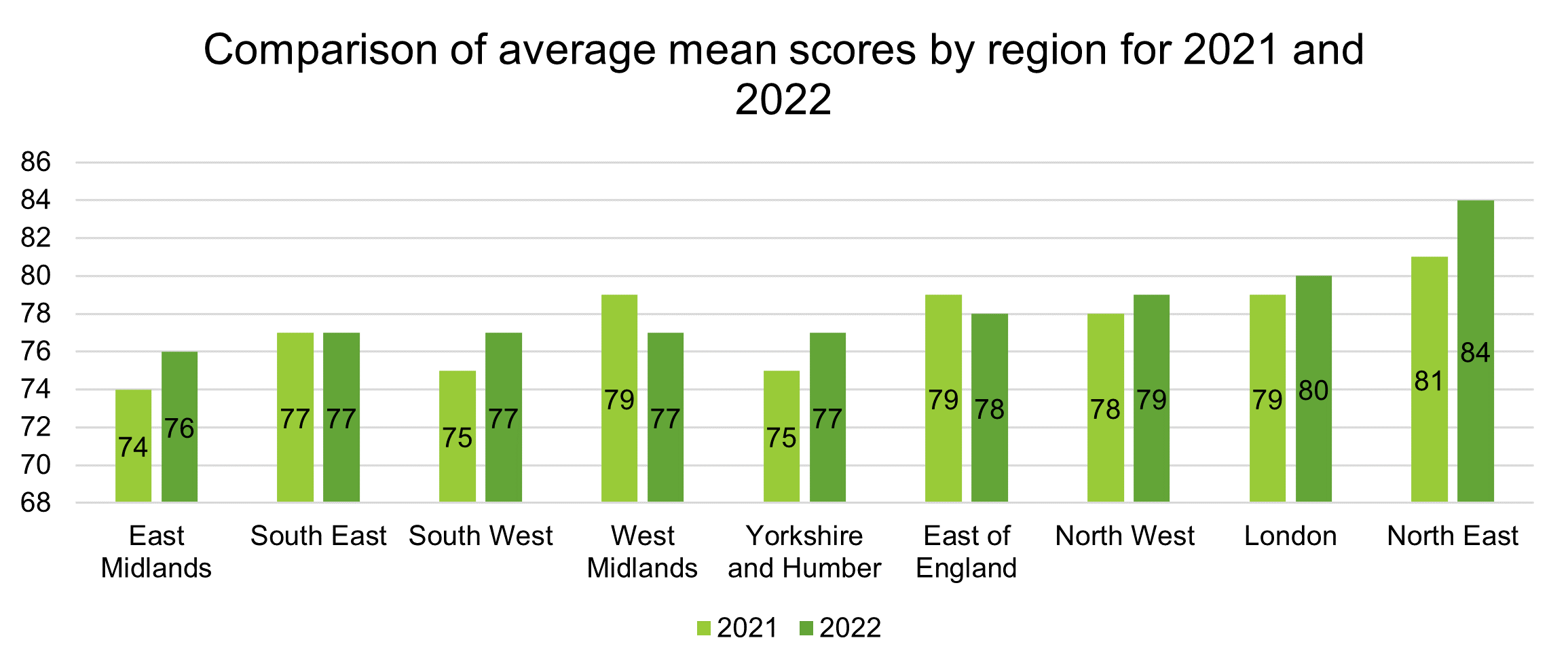Effective workforce planning systems (standard 2)
This standard received an overall mean score of 82 per cent and it was the most favourably received out of the 8 employer standards. In 2020, this standard received a mean score of 78, showing it has increased by 4 percentage points in 2 years.
Social workers strongly agree that they feel they are treated fairly and respectfully by all staff and that their supervisors or line manager encourage and motivate their career development. Similarly, social workers feel that they can access the training and development needed to carry out their role well and understand how their role fits into the organisational structure, however mental health social workers responded less positively that they understand how their ‘role fits into the organisation structure alongside the routes of entry and progression’ with a statistically significant difference on 5 percentage points to this question in comparison to adults’ social workers. The response to the rest of the questions for standard 2 were similar across the three occupational groups.
All but one question in this set received a mean score of 80+ which is in the good range (75+).The lowest scoring question that received a score in the moderate range (51-74) asked social workers whether they feel that their employer understands the barriers and challenges they face that get in the way of doing their best work. The question set for standard 2 can be seen in Appendix B.
Continuing Professional Development (standard 6)
This standard received an average mean score of 74 per cent, which is the top end of the ‘moderate’ range (51-74)
Standard 6 was the least favourably received standard across the 8 employer standards, which was also the case in the survey last year in 2021. In 2020, standard 6 received a score of 71 per cent, showing that this standard has improved slightly with an overall increase of 3 percentage points in 2 years. Children’s registered social workers responded slightly less favourably to 6 out of the 8 of the questions in standard 6 in comparison to adult’s and mental health social workers, but these responses were not statistically significant, with the exception to when social workers were specifically asked about appraisals and development plans. In these two questions that can be seen in Appendix B, there were statistically significant differences in satisfaction of 5 percentage points in response from children’s registered social workers.
The questions in the set for standard 6 were amongst those that received the lowest level of satisfaction scores as almost every question in the set received a ‘moderate’ mean score (51-74) with the exception where social workers strongly agreed that they keep up to date with their CPD and that their organisation provided non-discriminatory and transparent systems to enable them to develop. Some of the questions and mean scores can be seen in Appendix B which ask social workers how they feel about their professional development.
The low scores captured in the tables in Appendix B show that social workers do not feel entirely satisfied that they have the dedicated time, resources, and opportunities to carry out their CPD, and do not feel that they have an up-to-date plan of their professional development needs and how their employer will contribute to them. There is also room to improve the satisfaction from the AYSE programmes to help social workers develop and learn since the average overall score for this question had just entered a ‘good’ score range (75+).
Similarly, the scores suggest that there is room to improve the inductions and appraisal performance review systems so that they are more effective. Employers should be providing opportunities for regular and effective CPD and should provide support and information to enable social workers to progress and develop.
Safe caseloads and work allocation (standard 3)
This standard received an average mean score of 77 per cent.
The response to this standard remained unchanged when comparing it to the score from last year’s survey in 2021. In 2020, this standard received a mean score of 78 per cent showing there has been very little change to how social workers perceive the allocation of their workload and ability to balance their case work with the resources they have. Children’s social workers responded less favourably to all questions in this question set for standard 3 but not significantly so, with the exception to one question that asked social workers about the wellbeing support that is readily available to them. Children’s social workers responded significantly less favourably to this question with a statistically significant difference of 5 percentage points in satisfaction when comparing the response from adult’s registered social workers. This can be seen in Appendix B.
Most questions in this data set scored in the ‘good’ range’ (75+) however questions around caseloads specifically were close to the boundary of a ‘moderate score’. Some of the questions asked about caseload and work allocation can be seen in Appendix B.
In particular, when social workers were asked about balancing the demands of their casework, this question received a mean average score of 67, which was among the most poorly performing questions overall. The responses in this set show social workers generally feel that their work is allocated through a fair process and can access wellbeing support, though these questions also scored on the boundary of a moderate (51-74)/good (75+)range. This suggests that if there is no further improvement to the workload and case allocation, there could be a decrease in satisfaction levels across standard 3. Employers should continue to ensure work is allocated fairly and transparently and that social workers’ workload is assessed regularly to take account of work complexity, individual worker capacity and time needed for supervision and CPD.
Differences between registered social workers who are permanently employed and social workers who are represented by an agency, are a locum, interim or independently working social worker
7 per cent of registered social workers who were surveyed were represented by an agency, were locum/interim or independently working social workers.
Employer Standards
The survey found differences in satisfaction across the 8 employer standards when comparing social workers who are employed permanently and social workers who are represented by an agency, are locum/interim or independent working social workers. The table in Appendix B shows that social workers who are represented by an agency, are interim, locum or independent workers expressed higher levels of satisfaction across all but one standard (standard 6 - continuing professional development) in comparison to social workers who are employed permanently.
In particular, there are strong and statistically significant differences of 5 percentage points when comparing the performance of the standards in relation to a strong and clear social work framework, safe workloads and case allocation, and supervision.
The Workplace Experiences
The survey also asked social workers some supplementary questions to understand how they feel about their workplace experiences generally which can be seen in the table in Appendix B. The set of questions asked in the workplace experiences section sought to answer how social workers feel about their employee experience and their employment package more generally.
When focusing on social workers’ perception of the workplace, the data showed that there were some strong and statistically significant differences in the responses when comparing the experiences of social workers who are permanently employed and social workers who are represented by an agency, are locum/interim or independently working. In particular, the strongest difference of 12 percentage points can be seen when social workers were asked about whether they feel they must do more with fewer resources. Overall, permanently employed social workers feel less satisfied with their employment package and respond less positively across every work experience question.
Appendix B shows a breakdown of some of the lowest-scoring workplace experience responses that compare social workers who are employed permanently and social workers who are represented by an agency, are locum/interim or independently working.
Administrative burden
As part of the supplementary questions, social workers were also asked how they feel about the paperwork they must complete in their role which can be seen in table 9 in the appendix. In response to the statement which asked whether social worker’s ‘role involves burdensome paperwork’ this question received scores ranging from 72-74, showing general agreement with this statement. This question can be seen below in the table. There was a small difference in the response to this question where mental health social workers responded with less agreement to this statement than adult’s and children’s social workers
The data shows that social workers agree that their role involves burdensome paperwork that has little to no impact on the outcomes of families which may limit the effectiveness of their work.
Table: Comparison of mean average scores for the question about paperwork between social worker job category
|
Social Work Occupation
|
My role involves burdensome paperwork activities that have no or limited impact on outcomes for families (mean average)
|
|
Adults’ Social worker
|
74
|
|
Children’s Social worker
|
74
|
|
Mental Health Social worker
|
72
|



